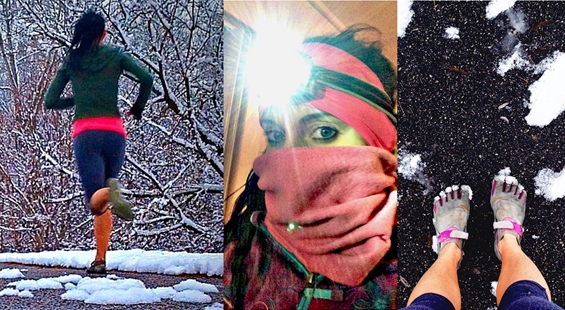Forefoot running in cold weather slightly abolishes proprioceptive feedback from the joints and feet. But the possibility of injury when forefoot running in cold weather is actually slim, only if you pay a little more attention to your mechanics.

Interestingly, runners under cold conditions landed with more hip flexion, which provides a cushioning effect at initial contact, and less hip abduction.
- Less hip abduction is a good thing because it minimizes compression between the IT band and the fat pad the lays beneath it thereby improving symptoms related to the infamous ITBS.
Moreover, runners under cold conditions showed a reduction in propulsion, vertical ground reaction force, and braking during running. So far this is good news for runners who must endure harsh winters.
2 Downfalls to Forefoot Running in Cold Weather
In the same study, the researches reported the runners under cold conditions had a prolonged stance phase, suggesting that forefoot running in cold weather may increase ground contact time.
Another potential downfall to forefoot running in cold weather is that it resulted in reduced ankle plantar flexion.
- Reduced ankle plantar flexion at foot strike causes the foot to land towards to the heel.
One possible explanation for the minor changes in joint kinematics when running in cold conditions is the loss of proprioception may cause a change in postures as a protective mechanism.
Slowed Response Time
At the neuromuscular level, coldness slows nerve conduction velocity meaning the speed of the transfer of information from one nerve cell to another is reduced. Therefore, muscles may show a delayed response to a specific stimulus which may negatively affect performance. This probably explains the increased ground contact time in the runners under cold conditions.
But if you are an experienced forefoot runner, you will know that much of the movements related to forefoot running is under reflexive, involuntary control meaning less muscle force generation is involved. Therefore, forefoot running in cold weather probably won’t affect movement efficiency if you know what you are doing.
The Take Home Message
Forefoot running in cold weather is not bad. The only things a forefoot runner should be more aware of is the risk of longer ground contact time and a toe-lift (less ankle plantar flexion) at touchdown. These are the only changes in kinematic variables to look out for when you are running in the snow.
More From Run Forefoot:
- Othotics: a Danger to Forefoot Running
- Forefoot Running Good for Anterior Shin Splints
- Recommended Forefoot Running Shoes
- External Focus of Attention Better for Learning Forefoot Running
References:
Fukuchu et al. Effects of cold water immersion on lower extremity joint mechanics during running. J Sports Sci, 2015; 33(5):449-56.
Bretta Riches
BSc Neurobiology; MSc Biomechanics candidate, ultra minimalist runner & founder of RunForefoot. I was a heel striker, always injured. I was inspired by the great Tirunesh Dibaba to try forefoot running. Now, I'm injury free. This is why I launched Run Forefoot, to advocate the health & performance benefits of forefoot running and to raise awareness on the dangers of heel striking, because the world needs to know.
Latest posts by Bretta Riches (see all)
- Can You Run In Barefoot Shoes? Yes, But DON’T Heel Strike! - 21/07/2024
- Why Cushioned Running Shoes Are Really Bad for Your Feet - 19/07/2024
- Do Cushioned Running Shoes Cause Injuries? - 17/07/2024

Leave a Reply